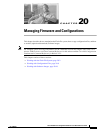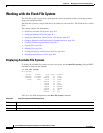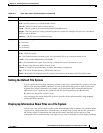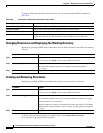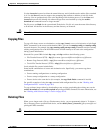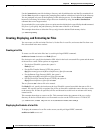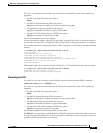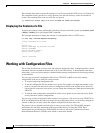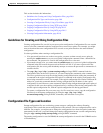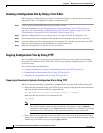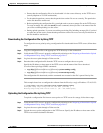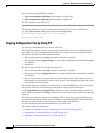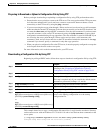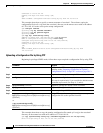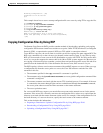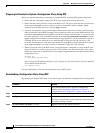
20-9
Cisco IOS Software Configuration Guide for Cisco Aironet Access Points
OL-11350-01
Chapter 20 Managing Firmware and Configurations
Working with Configuration Files
This section includes this information:
• Guidelines for Creating and Using Configuration Files, page 20-9
• Configuration File Types and Location, page 20-9
• Creating a Configuration File by Using a Text Editor, page 20-10
• Copying Configuration Files by Using TFTP, page 20-10
• Copying Configuration Files by Using FTP, page 20-12
• Copying Configuration Files by Using RCP, page 20-15
• Clearing Configuration Information, page 20-18
Guidelines for Creating and Using Configuration Files
Creating configuration files can aid in your access point configuration. Configuration files can contain
some or all of the commands needed to configure one or more access points. For example, you might
want to download the same configuration file to several access points that have the same hardware
configuration.
Use these guidelines when creating a configuration file:
• If no passwords have been set on the access point, you must set them on each access point by
entering the enable secret secret-password global configuration command. Enter a blank line for
this command. The password is saved in the configuration file as clear text.
• If passwords already exist, you cannot enter the enable secret secret-password global configuration
command in the file because the password verification will fail. If you enter a password in the
configuration file, the access point mistakenly attempts to execute the passwords as commands as it
executes the file.
• The copy {ftp: | rcp: | tftp:} system:running-config privileged EXEC command loads the
configuration files on the access point as if you were entering the commands at the command line.
The access point does not erase the existing running configuration before adding the commands. If
a command in the copied configuration file replaces a command in the existing configuration file,
the existing command is erased. For example, if the copied configuration file contains a different IP
address in a particular command than the existing configuration, the IP address in the copied
configuration is used. However, some commands in the existing configuration might not be replaced
or negated. In this case, the resulting configuration file is a mixture of the existing configuration file
and the copied configuration file, with the copied configuration file having precedence.
To restore a configuration file to an exact copy of a file stored on a server, copy the configuration
file directly to the startup configuration (by using the copy {ftp: | rcp: | tftp:}
nvram:startup-config privileged EXEC command), and reload the access point.
Configuration File Types and Location
Startup configuration files are used during system startup to configure the software. Running
configuration files contain the current configuration of the software. The two configuration files can be
different. For example, you might want to change the configuration for a short time period rather than
permanently. In this case, you would change the running configuration but not save the configuration by
using the copy running-config startup-config privileged EXEC command.
The running configuration is saved in DRAM; the startup configuration is stored in the NVRAM section
of Flash memory.



